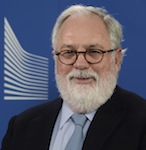
Achieving European Global Leadership in Renewable Energy
The Paris Agreement represents a historic milestone in the fight against climate change, and its ratification sent a strong signal that the world is moving towards a global clean energy transition, a transition that is already underway and that is unstoppable.
During last November’s COP 23 in Bonn and during the One Planet Summit organized by President Macron last month in Paris, it was confirmed what we already knew; the European Union will continue to lead the way in the fight against climate change and in the clean energy transition.
And we are leading by example, through some of the most ambitious climate commitments and policies in the world and through continued support to the poor and vulnerable; we can’t forget that the EU and its Member States are the biggest contributors of climate finance to developing countries globally.
Implementing the Paris Agreement is not only a matter of a responsible climate change policy. It also represents an enormous opportunity for EU businesses to maintain and exploit their first mover advantage when fostering renewable energy, energy efficiency, and competing on the development of other low carbon technology market globally.
Renewables will be the cornerstone to Europe’s transition to a low-carbon society.
By 2030 half of the electricity generated in Europe will be renewable, and the system should be fully decarbonised by 2050.
The transformation of global power markets is already ongoing; in 2015 renewable energy surpassed for the first time coal as main source of power capacity, and the renewable energy sector employed over 1.1 million people in Europe and created a turnover of around € 153 billion1.
We can see that the share of renewables in the EU energy mix continues to rise. With a 16.7% in 2015, we are on track to reach our 2020 target of 20%.
However, whichever way we look at it, the energy system of tomorrow will have to look completely different to how it does now, and this implies very significant challenges to be addressed. Among them, the need for a stable regulatory framework that enables the development of renewable energy at the lowest possible cost.
This is why on November 2016 the European Commission presented the Clean Energy Package for All Europeans. The Package proposes a wide range of measures to keep the European Union competitive as the clean energy transition changes global energy markets.
Achieving global leadership in renewable energies is at the centre of this package, setting a target to collectively reach a share of at least 27% renewables in the final energy consumption by 2030.
The Renewable Energy Directive of the Package includes general principles that Member States should follow when designing support schemes.
While providing certainty to investors, support schemes must be cost-effective and market oriented.
The aim is to ensure their stability, bring down the costs of deploying renewables and make our renewable energy policy a truly European one.
Furthermore, the Directive fosters the mainstreaming of renewables in the heating and cooling sector, and acknowledges that consumers are the drivers of the energy transition.
For instance, it enables consumers to self-consume renewable electricity without facing undue restrictions, and ensure that they are remunerated for the electricity they feed into the grid.
The clearer legal framework provided by the new directive will remove uncertainties for investors, and reduce administrative burdens and costs, while keeping us on track to meeting our climate and energy targets.
This will bring benefits for producers, investors and consumers: renewable energy technology suppliers will keep a leadership role; costs of renewables supply chains will be lowered and consumers will see the benefits on their bills.
From an economic perspective, this package goes beyond energy: it’s an opportunity for investments, growth and jobs.
The negotiations on the Clean Energy for All Europeans Package are advancing and it is now up to the co-legislators to finalize these.
If we want to secure a global number one position, we need to remain very ambitious on the Renewables Directive, and this will be the number one priority for the Commission during the negotiations.
Thanks to renewables, Europe could save around € 60 billion per year by 2030 in terms of avoided fossil fuel imports; this is the equivalent to the current GDP of Luxembourg.
But if we want to achieve a fully decarbonized electricity system, we have to integrate the growing amount of renewable energy into the electricity grid without distorting the European electricity market. Boosting the necessary infrastructure to assure Europe’s security of supply is crucial; and as highways do not stop at national borders, neither should cables.
The main tool for reaching our target of 15% electricity interconnection by 2030 is by rapidly building the necessary cross-border infrastructure links that connect the energy systems of EU countries.
Last November the Commission presented its third list of Projects of Common Interest (PCIs), 173 projects, of which 110 are electricity and smart grids projects, that will help better integrating the renewables potential of countries and reduce current barriers to trade with neighbouring Member States. All these projects benefit from accelerated licensing procedures, improved regulatory conditions, and in some instances have access to financial support.
The PCI list completes the regulatory proposals of the Clean Energy Package with a clean infrastructure dimension.
As the European Commissioner for Climate Action and Energy, I am deeply convinced that the adoption of all these measures will help us achieve our ambitious decarbonisation objectives.
But it will also allow the European Union to lead the renewable energies sector globally.




